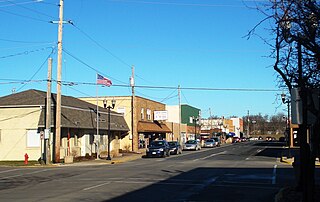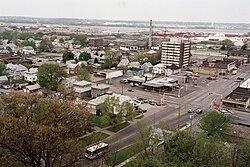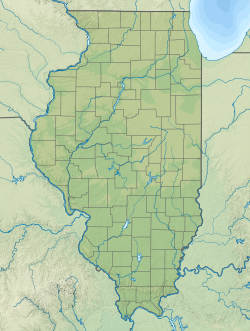
Scott County is a county located in the U.S. state of Iowa. As of the 2020 census, the population was 174,669, making it the third-most populous county in Iowa. The county seat is Davenport.

Rock Island County is a county located in the U.S. state of Illinois, bounded on the west by the Mississippi River. According to the 2020 census, it had a population of 144,672. Its county seat is Rock Island; its largest city is neighboring Moline. Rock Island County is one of the four counties that make up the Davenport-Moline-Rock Island, IA-IL Metropolitan Statistical Area.

Catoosa County is a county located in the northwestern part of the U.S. state of Georgia. As of the 2020 census, the population was 67,872. The county seat is Ringgold. The county was created on December 5, 1853. The meaning of the Cherokee language name "Catoosa" is obscure: "Catoosa" may come from the Cherokee words gatusi or gatu'gitse.

Dover is a village in Bureau County, Illinois, United States. The population was 135 at the 2020 census. It is part of the Ottawa Micropolitan Statistical Area.

Thomson is a village along Illinois Route 84 near the Mississippi River in Carroll County, Illinois, United States. The population was 590 at the 2010 census, up from 559 at the 2000 census. Just north of the village is the United States Penitentiary, Thomson, a mostly-unused former state prison, purchased by the Federal Bureau of Prisons in 2012. Currently USP Thomson houses over 100 low-security inmates as it remodels to federal maximum-security standards.

Calumet Park is a village in Cook County, Illinois. The population was 7,025 at the 2020 census.

Forest View is a village in Cook County, Illinois, United States. Per the 2020 census, the population was 792. It is primarily an industrial corridor adjacent to the Chicago neighborhood of Garfield Ridge, which is on the village's southern border.

Glendale Heights is a village in DuPage County, Illinois, United States. Per the 2020 census, the population was 33,176. The village is almost entirely residential, and is a far west suburb of Chicago.

The village of Coal Valley is located in both Rock Island County and Henry County in the U.S. state of Illinois. The population was 3,873 at the time of the 2020 census, up from 3,743 at the 2010 census. It is mostly residential, housing families who work in or out of the greater Quad Cities Area and is considered a suburb. The students of the Rock Island County part of Coal Valley attend the Moline School District number 40, and in the Henry County portion, Orion Community Unit School District 223

Colona is a city in Henry County, Illinois, along the Green River. It is part of the Quad Cities metropolitan area. The population was 5,307 at the 2020 census, up from 5,099 at the 2010 census.

Fairmont City is a village in St. Clair and Madison counties, Illinois, United States. The population was 2,265 at the 2020 census, down from 2,635 in 2010. In the 1990s Fairmont City's Hispanic population doubled, and as of 2020, over 79% of the population was of Hispanic descent.

Venice is a city in Madison County, Illinois, United States. The population was 1,498 at the 2020 census, down from 1,890 in 2010.

Prairie City is a village in McDonough County, Illinois, United States. The population was 407 at the 2020 census.

Milan is a village in Rock Island County, Illinois, United States. The population was 5,097 at the time of the 2020 census; down from 5,099 at the 2010 census.

Rock Island is a city in and the county seat of Rock Island County, Illinois, United States. The population was 37,108 at the 2020 census. Located at the confluence of the Rock and Mississippi rivers, it is one of the Quad Cities along with neighboring Moline and East Moline in Illinois and the cities of Davenport and Bettendorf in Iowa. The Quad Cities had a population of 384,324 in 2020. The city is home to Rock Island Arsenal, the largest government-owned weapons manufacturing arsenal in the US, which employs 6,000 people. The original Rock Island, from which the city name is derived, is now called Arsenal Island.

Centreville was a city in St. Clair County, Illinois, United States. The population was 5,309 in 2010, down from 5,951 at the 2000 census. On May 6, 2021, the city ceased to exist, being incorporated along with Alorton and Cahokia into the new city of Cahokia Heights.

Durant is a city in Cedar, Muscatine, and Scott counties in the U.S. state of Iowa. The population was 1,871 at the time of the 2020 census.

Grand Mound is a city in Clinton County, Iowa, United States. The population was 615 at the time of the 2020 census.

LeClaire is a city in Scott County, Iowa, United States. The population was 4,710 in 2020, a 65.4% increase from 2,847 in 2000, making it one of the fastest-growing communities in the Quad Cities. LeClaire is considered a suburb and part of the Quad Cities Metropolitan Area, which includes the area of Davenport and Bettendorf, Iowa, and Rock Island, Moline, and East Moline, Illinois.

Riverdale is a city in Scott County, Iowa, United States. The population was 379 at the time of the 2020 census.

























